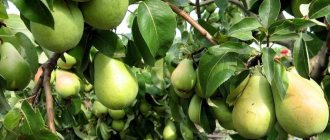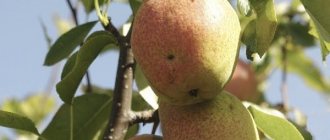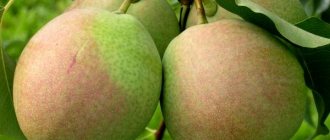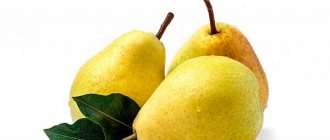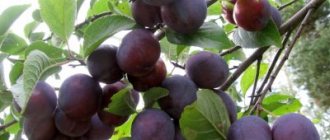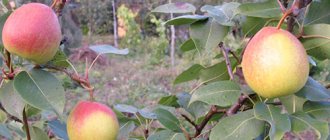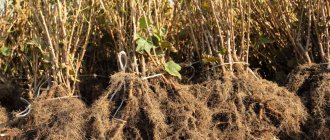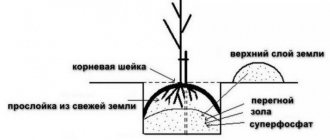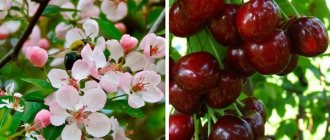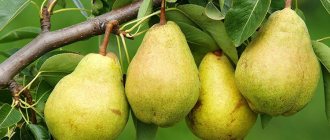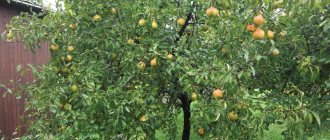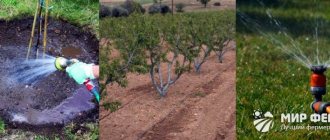Gardening » Pear
0
1129
Article rating
Kira Stoletova
Many gardeners grow early varieties of pears. They are suitable for regions where autumn comes quickly and frosts begin quickly. Therefore, it is especially important to cultivate them in central Russia. These species differ in comparison by their small but sweet fruits. Their ripening occurs from mid-July to the end of August.
Characteristics of early pear varieties
"Early Summer"
This is an early ripening pear. It is popular throughout Russia, and its ripe fruits can be harvested from mid-July.
The tree is medium-sized, its crown is pyramid-shaped, very dense. The branches are beautiful, even, constantly raised up, as if they want to reach the sun. The bark has a gray or gray-green tint and peels off. The shoots grow brown-brown in color and have small lentils on them. The leaves are short-pointed, smooth, without pubescence, and have a light green color. When flowering, the tree does not have an aroma, as happens with other flowering plants. Flower petals are oval.
Care
Caring for pear varieties Mlievskaya winter and early is limited to watering, fertilizing, pruning and treating the trunk circle. Useful materials on the topic of growing pears can be found in the selection of articles listed below.
How to care for a pear Pruning a pear Pruning a columnar pear Treating a pear from diseases and pests Feeding a pear How to water a pear
Description of fruits
Today we are talking about varieties of early pears. You can see a description and photo of each type in this article.
Speaking about the “early summer” pear, gardeners note that even the most ripe fruits do not fall off the tree for a long time. The taste of this pear is amazing, sweet and sour. The pulp is white, aromatic and juicy, as if it melts in the mouth if the fruit is well ripe.
The skin of this pear is thin, matte, and has a yellow-green tint. When the fruit is fully ripe, it turns lemon yellow and has a slight pink blush. Small dots become visible under the skin.
The fruits are small in size, weighing only up to 120 grams, but this is compensated by their excellent taste. The pears are bottle-shaped, their surface is even and smooth.
By planting a seedling of this variety on your plot, you will be able to enjoy the described fruits in the sixth year after planting.
"Early Moldavian"
The earliest varieties of pears are famous for their beautiful appearance and excellent taste. It is rare that a late variety can boast of the absence of an astringent sour taste, which few people may like. One can safely count “Moldavian” among the early varieties of pears, since its juicy and ripe fruits are harvested from mid-July to mid-August, depending on climatic conditions and care. This variety was obtained by crossing “Williams” and “Clapp’s Favorite”.
The tree is tall and powerful. Its crown is dense, extensive, and seems compressed. The foliage is dense, dark green, the usual shape is oval, short-pointed.
Fruit
Early varieties of pears are rarely large. “Moldavian early” is no exception, and one fruit can weigh up to 50 grams. But, again, this size makes up for the taste: sweet and sour, aromatic. The pulp is creamy, juicy and oily.
This variety belongs to the category of frost-resistant, therefore ideal for growing in the middle zone. Experienced gardeners advise planting pollinating varieties next to the “Moldavian” to obtain maximum yield. “Bere giffard”, “swallow” and “beautiful” are ideal for these purposes.
Fruiting occurs in the third or fourth year after planting the cuttings. Productivity is stable and quite high. On average, one tree produces seventy kilograms of fruit.
Comparative table of characteristics of summer pear varieties
| Variety name | Ripening period | Color fruits | Stable to diseases | Winter. | Taste, tasting grade | Fruit weight | The power of growth | Speed-of-fertility | Yield | Self-fertility | Note |
| Dubovskaya early | 1st ten days of August | Green- yellow with red blush | High to the scab | High | Very good chorus | 125-130 | Avg. | 5 year | High Annually. | ||
| Clapp's Favorite | 2nd ten days of August | Yellow-green with blush | Weak to the scab | High | Very good chorus 4,3-4,5 | 230g. | Medium-strong | 7 year | High Annually. | s/infertility Pollinators: Bere Giffard, Williams, Forest Beauty, Olivier de Serre. | |
| Rossoshanskaya is beautiful | 2nd ten days of August | Yellow with red | High | High | Chorus. 4,0 | 115-120 g. | Strong | 6 year | High (70-80kg/tree, max. 1000 c/ha) | Ch./self-pl. | |
| Lada | 1-2 decades of August | Yellow with red blush | good to the scab | High | Chorus. 4,3 | 100-110 g. | Weak –avg. 2.5-3 m | 2-4 years | High Annually. | Self-fertile. | |
| Radiant | 1-2 decades of August | Green-yellow with burgundy blush | High | High | Very good Chorus. | 120-150 g. | Avg. | 5 year | High | ||
| Skorospelka from Michurinsk | 2nd decade of July | Yellow | High to the scab, average to moniliosis | High | Very good Chorus. | 80-100 g | Strong | 5 year | High Annually. | Self-fertile. | |
| Duchess summer (Williams summer) | 3rd ten days of August | St. green when ripe yellow | good | Avg. | Exc. With a hint of nutmeg 4,6 | 170-180g. | Avg. | 4-5 year | High (if pollinator is present) | s/infertility | |
| Starkrimson | 3rd ten days of August | Red | Higher average to the scab | Avg. | Exc. 4,8 | Up to 260g. | Strong | 5-7 year | Good (if there is a pollinator) | Prone to shedding | |
| Bere Giffard | 3rd decade of July | Yellow-green with red-orange blush | High to the scab, to moniliosis low | Higher average | Chorus. 4,3-4,6 | 75-120g | Avg. | 6-7 year | Good (in the presence of a pollinator 100 c/ha) | Not easy | |
| Skorospelka from Trevou | 2nd ten days of July | Light yellow | High | High | Chorus. 4,4 | 170g. | Strong | 4-5 year | High (200 c/ha, max.-350 c/ha) | Stored for 2 months. | |
| Bohemia | 1st ten days of August | Light green with faint blush | High to the scab, average to bacterial burn | High | Very good choir 4,7 | Up to 180g. | Avg. | ||||
| Vesilna | 3rd ten days of August | Yellow with burgundy-red blush | High to the scab | High | Exc. 4,8 | Up to 250g. | Avg. | High | |||
| Red Favorite | 2nd ten days of August | Green with rich red blush | High | Avg. | Very good chorus 4.6 | Up to 170g. | Avg. |
Read more: Cherry plum tree fruit and berry crops how it grows description pollinators
"July Early"
This species is one of the best varieties of early pears. The fruits ripen in mid-July. The founders of the variety were our compatriots E.I. Kostetskaya and L.M. Sergeev.
The tree is of medium height, has a dense, rounded, lush crown. The branches are even, straight, rising upward. The bark is usually brown, but can also be greenish-brown and flaky. The leaves are oval, finely serrated at the edges and pointed at the tip. The color is bright green, rich, glossy. Blooms abundantly, without aroma, flowers are white, with oval-shaped petals.
Skorospelka from Michurinsk
If you need a large harvest of delicious summer pears, and their size is not important, then Skorospelka from Michurinsk is just right. Pears grow 80-100 grams, rarely more, but there are so many of them! The variety is self-fertile, therefore it is productive, but if you plant the autumn variety Pamyat Yakovlev nearby, the harvest will still grow, because These varieties pollinate each other.
One of the relative disadvantages is being tall. But maybe someone just needs a tall tree, who knows. Regarding diseases: resistance to scab is high, to moniliosis, alas, not very much.
Description
Skrospelka from Michurinsk is an early summer variety. Bred at the All-Russian Research Institute of Genetics and Selection of Fruit Plants named after. I. V. Michurina. Zoned in the Central and Middle Volga regions.
Pears ripen in Volgograd in mid-July. Consumption period – 2 weeks. The fruits are not stored for a long time; they can sit in the kitchen for a week, in the refrigerator - up to 2 weeks.
Productivity is high. Fruits every year.
The tree is tall and fast growing. The crown is pyramidal, of medium density. The branches extend at an acute angle.
The fruits are below average size, ideal pear-shaped. With a large harvest they become smaller. The color at removable maturity is greenish-yellow, during the consumer period it is yellow.
The pulp is tender, juicy, loose, sour-sweet, without astringency or granulation. The fruits contain sugars - 8.2%, acidity - 0.78%, vitamin C - 13.5 mg/100g, P-active substances - 120 mg/100g. The taste is excellent.
The variety is early-bearing, pears begin to bear fruit 5 years after planting in the garden. At the age of 10 they give up to 100 c/ha. Winter hardiness and frost resistance are high. At state tests, Skorospelka from Michurinsk showed itself to be one of the most frost-resistant varieties. When artificially frozen, it adequately withstood even such a low temperature as -40 °C.
Resistance to scab is high; in some years, with a large harvest, it is affected by moniliosis.
Read more: Cherry plum (plum) found description of variety photo reviews
Fruits of universal use. Very good for canning - this variety makes excellent juices, compotes, confitures, jams and preserves.
Very tasty pears, tasting score - 4.8 points out of 5, with nutmeg notes. It is considered a classic pear (in taste). But pollinating varieties need to be planted nearby, since Williams is a self-sterile variety. If there are pollinators nearby, the yield is high; from an adult tree it can reach 150 kg, or even more. Another disadvantage is low winter hardiness. The variety does not like winds, especially dry ones.
Summer dessert variety of pears. Ripens in August.
The tree is medium-sized, grows up to 4-5 m. It has a dense, spreading crown in the form of a wide or rounded pyramid
Winter hardiness, frost resistance, and drought resistance are low.
13.8% dry matter;
8.3% sugars;
0.42% acids;
5.4 mg per 100 g of ascorbic acid;
P-active catechins - 42.6 mg per 100 g;
On a 5-point scale, the tasting assessment of the fruits of the Williams variety (Duchess Summer) is 4.8 points.
The shape of the fruit is oblong pear-shaped, the fruits have a bumpy top. The color of the fruit when harvested is light green, after resting it is waxy yellow. The peel is thin.
Size is average and above average - approximately 170-180 g.
Fully ripe pears can sit for a week; if removed in a timely manner (before yellowing), they can be stored in the refrigerator for up to 45 days.
The fruits can be eaten fresh, dried, or made into compotes or jams.
Scab resistance is good. The variety suffers from aphids and copperheads.
The Williams variety (Summer Duchess) is self-sterile. Next to it you need to plant a pollinator variety, for example: Forest Beauty, Clapp's Favorite, Olivier de Serre, Pass Crassan, Bere Beauce,
Alexandrovka.
The variety is early-bearing and produces a harvest within 4-5 years. In the presence of a pollinator neighbor, a ten-year-old tree of the Williams (Duchess Summer) variety produces 35 kg of harvest, and a twenty-year-old tree - 150 kg.
The variety is unpretentious, but grows best in fertile soil with sufficient water.
The Williams variety (Duchess summer) was zoned in the North Caucasus, Krasnodar Territory, Adygea, Dagestan, North Ossetia, Kabardino-Balkarian, Karachay-Cherkess, Chechen and Ingush republics. The variety is widespread in Rostov, Stavropol, Volgograi, Moldova, Ukraine and other southern regions.
The Williams pear variety was developed around 1796 in the English county of Berkshire. The name appeared in connection with the name of R. Williams, thanks to whom the variety became popular.
Bere GiffardIlyinka
Fruit characteristics
The fruits, like all early varieties of pears, are small, each weighing on average 130-160 grams. The shape is usual pear-shaped, slightly elongated. The skin is tender and thin, has a greenish-yellow color. When picking fruits, you should pay attention to the color; when fully ripe, it turns bright yellow.
The pulp is very juicy, soft, sweet and sour taste, without astringency. The tree will begin to bear fruit from the sixth year of life. Productivity is stable and good. This variety is highly frost-resistant and will easily survive harsh winters with thick snow cover at air temperatures down to -30 degrees.
Rossoshanskaya is beautiful
Review: There are tastier pears. However, the variety, of course, has its main advantages: productivity, disease resistance, winter hardiness, and the beauty of the fruit.
Description.Summer variety of pears. Fruit ripeness occurs in mid-August.
The trees are vigorous.
The fruits are of medium size, weighing 115-120 g. The skin is thin. The main color is whitish-yellow, the outer color on most of the fruit is dark red, blurred. The pulp of the fruit is yellowish, juicy, tender, sourish-sweet. The appearance of the fruit is very attractive (4.6 points), the taste is good (4.0 points).
The fruits are firmly held on the tree until ripe. The transportability of the fruits and their marketability are high. A variety of universal use. Produces excellent quality compotes (4.5 points).
It begins to bear fruit at 6-7 years.
The variety is partially self-fertile.
Read more: High-flying pigeons description of photo types
Productivity is high. 70-80 kg per tree. The highest yield recorded was 1000 c/ha.
Winter hardiness is high.
Drought resistance is average.
The variety is resistant to diseases.
Early ripening pear
At the end of July you will be pleased with the fruits of an early ripening pear of the “early ripening” or “early ripening” variety. This variety was developed by S.P. Yakovlev, and he had to work hard before obtaining a decent result. Three varieties were used in the breeding of “early ripening”: “Bire Ligel”, “Ussuriyskaya” and “Citron de Carme”.
The tree is fast growing and tall. Its appearance is very interesting, the branches extend upward from the trunk at right angles, forming a dense, pyramidal crown. The foliage is dark green, elongated, pointed.
Taste qualities of fruits
The fruits are quite small, no larger than a chicken egg and of the same shape. Initially, the skin has a green tint, but when fully ripe it becomes more yellow. There are small “rusty” spots on the surface of the peel. The fruits are unattractive in appearance, and therefore it seems that the taste will be the same. But after trying, you will see the opposite. The unsightly and tough-looking peel is actually very thin and delicate. The pulp is juicy, more sweet than sour, and has no astringency. The taste of pear is excellent; it is soft, buttery and refreshing. Reviews confirm this.
After ripening, the fruits are stored for no more than two weeks. “Early ripening” pears are consumed mainly fresh, or juices are prepared from them, as they are very juicy. The tree will bear fruit in its fifth year. It tolerates harsh winters easily, so it can be grown throughout Russia.
"Mlievskaya early"
In this article we describe pears - early varieties. You can see their photos here. It is worth noting that early varieties are divided into groups: early summer, mid-summer, late summer. “Mlievskaya” is a mid-season variety, and its fruits can be harvested from the beginning of August. I. A. Shidenko was involved in breeding the variety and used “Ukrainian Gliva” and “Esperen” for crossing. As a result of this relationship, a tree grew that grew up to five meters. The color of the bark is burgundy-brown, the branches are spreading and lush, the tree needs a very large space for full development!
Landing
Proper planting is very important so that the seedling quickly gets stronger and begins to develop. Detailed instructions for planting pears of the July Early variety can be found by clicking on the links below.
How to plant a pear tree correctly
At what distance to plant pears?
How to choose pear seedlings
How to replant a pear
Size and taste of pears
The variety has gained its fans in the north-west of Russia, Ukraine and Latvia. The tree has high frost resistance and immunity to various diseases and pests.
The fruits are wide, pear-shaped, small, weighing only up to one hundred grams. But, like all early varieties of pears, they are endowed with extraordinary taste. The pear tastes sweet, with a slight sourness. The pulp is very tender and soft, creamy in color. The skin is transparent and thin, honey-yellow in color; when fully ripe, it becomes covered with a delicate pink blush. After harvesting, gardeners advise storing the harvest in a cool and dark place; its shelf life is two months.
The yield is high; from one tree you can collect from seventy to one hundred and twenty kilograms of ripe medium-sized fruits.
Diseases and pests
The tree has good resistance to scab, but it still needs regular preventive measures. In the articles selected below, you can find a lot of useful information on protecting Lepotika pears from diseases and pests.
Dangerous Pear Pests
Pears often suffer from pests, they affect the leaves, bark and fruits.
In this article, we have selected 11 of the most harmful insects that harm pear trees, and also ways to destroy them.
Diseases of pear trees
To get what they cherish, gardeners have to work hard, and the reason for this is pear diseases.
Read about 19 common pear diseases and how to combat them.
"Moscow Early"
This variety will give you a harvest in late July and early August, depending on climatic conditions. It is frost-resistant, high-yielding. The breeding of the “Moscow early” pear dates back to 1991, and its creator was the Honored Agronomist of the Russian Federation V.I. Susov. There are quite a lot of “parents” of the variety, so we won’t go into details.
The result is an amazing variety of pear; the tree can grow up to five meters under favorable conditions and begins bearing fruit in the sixth year after planting the cutting. The trunk and branches are greenish in color with a gray tint. The crown is not too dense, pyramidal.
Fruits and their taste
The round-conical beauty pear is small, its average weight is 130 grams. Taste rating: 5 out of 5 possible. That is, it is endowed with ideal taste qualities. The pulp is white or cream-colored, coarse-grained in consistency, soft, very juicy and sweet, endowed with a delicate, pleasant aroma.
The skin is quite dense, but soft. It has a greenish-yellow color, and when fully ripe, it will turn brown on the side that received more sun. This “tan” consists of orange-red dots, and they can be seen without even looking too closely.
The yield of the variety is high, the same frost resistance. This variety loves moisture, so do not skimp on watering and do not worry if prolonged rains begin. The fruits ripen at the same time, so you only have to climb to the top once! But, having collected a rich harvest, share with your neighbors, since the pear is stored for only five days, and in the refrigerator - no more than two weeks.
We wish all gardeners a successful summer season and a high harvest!
Reviews
Valery
Taganrog
Mlievskaya winter has been growing in our garden for about 10 years now. The tree is unpretentious and can be grown without problems. There are not very many pears, but there is enough to store for the winter. They lie without loss.
Lesya
Ukraine
I have both types of Mlievskaya growing in my garden, both early and winter. I specially grow the first one for jam, drying and eating fresh. I put the winter ones in the basement to store them. We start eating only in December, there is enough until April.
Svyatoslav
Avdeevka
Mlievskaya winter is an excellent variety. The tree, although tall and bushy, can be grown without any problems. It doesn’t get sick or freeze, it’s just very thick and you have to cut it off often.
